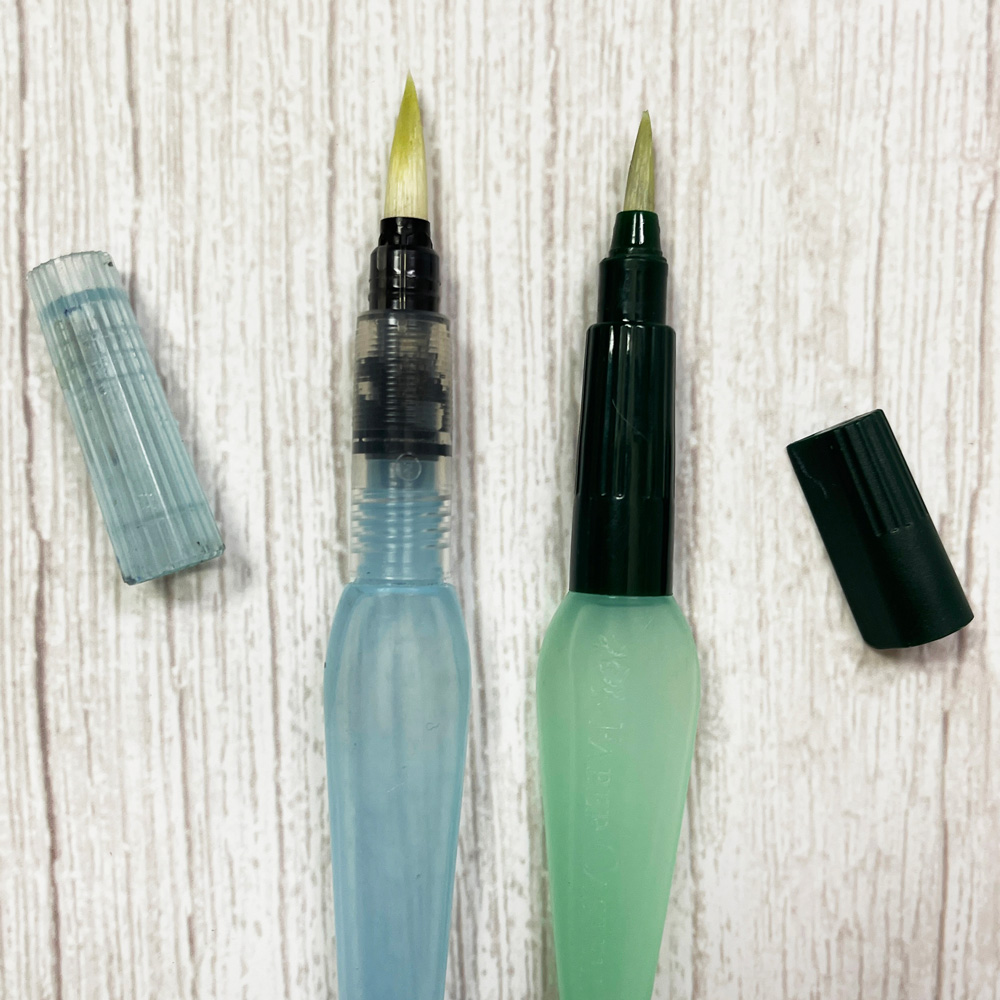
I’ve decided to start using a water brush for the next few weeks to find out if there is a way of using it so that I’m happy with the results.
Water brushes are extremely convenient but over the years I’ve always been disappointed when I’ve used them. Watercolour sketches painted with a water brush are generally less vibrant and contain less watercolour magic compared to those created with a normal brush. In the past when I’ve used a waterbrush I’ve wished I had taken the time or effort to get my normal dagger brush and water container out and use it instead.
But for the next few weeks, I want to persevere using a waterbrush and work out the best way to use it.
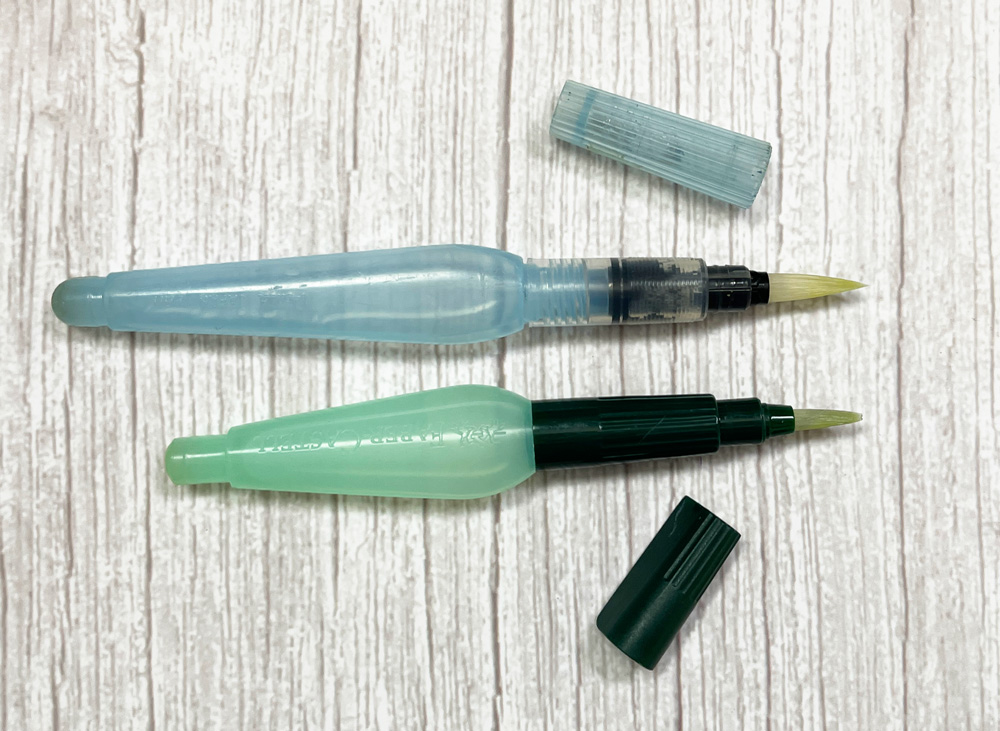
If you have never come across a waterbrush before…
A water brush is a synthetic brush that contains a barrel of water in the handle. By simply slightly squeezing the barrel, water is released into the brush bristles so that you can mix your paint and apply washes without the need for a separate water container. This makes it the perfect tool for an on-location sketching kit!
The amount of water in the brush is controlled by how much you squeeze the barrel and how much you blot the bristles. To clean the brush you simply squeeze and blot until all the paint in the bristles is cleaned out.
It’s the combination of the synthetic bristles (as opposed to natural hair) and the fact that it is harder to control the amount of water in the brush means waterbrushes have a tendency to produce flatter washes.
I know from experience that the best way to use water brushes is to make sure that the washes I mix in my palette are very juicy (a term from my Watercolour course) and so I decided to do some swatches using this technique.
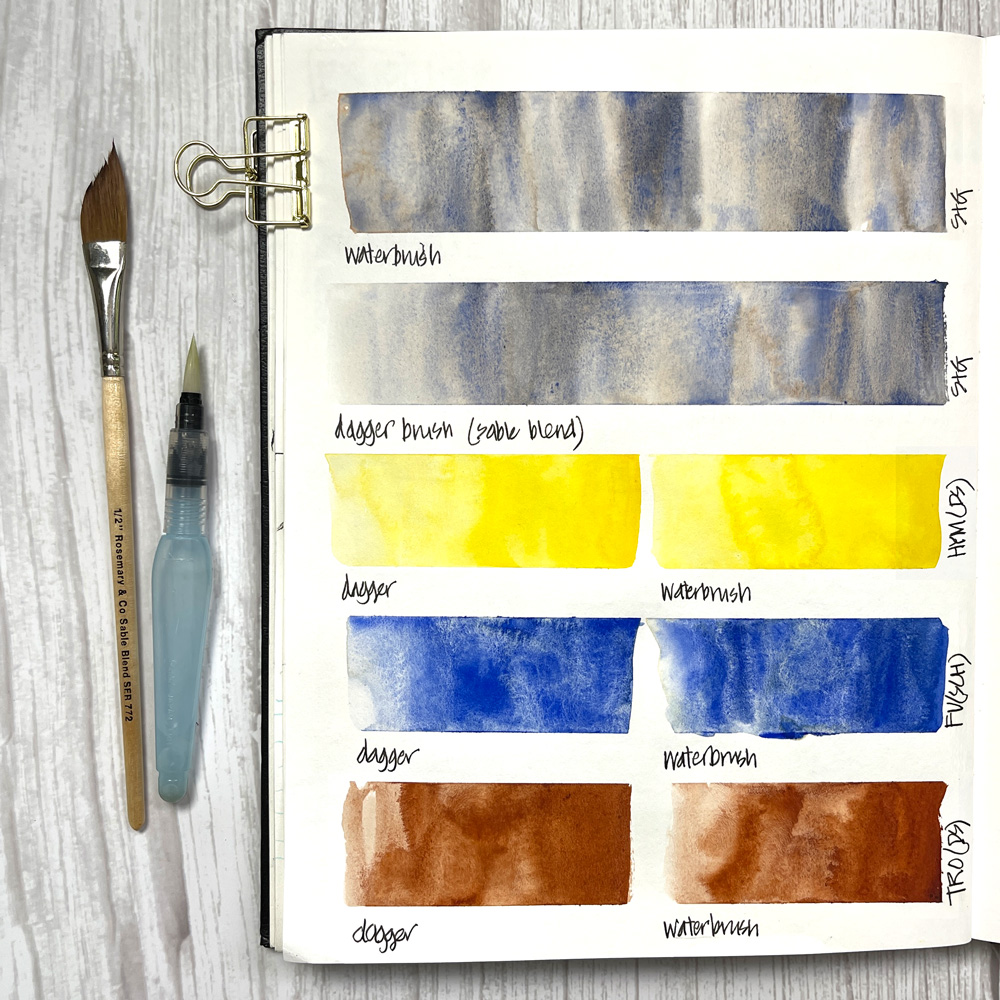
I was very pleasantly surprised by the results of these swatches! There is really no difference between the water brush swatches and the ones done with my sable blend dagger brush (the brush I use most of the time).
So the real question is whether I will be able to get these results in the context of an actual sketch done on location.
These swatches were done with the Large Aquash brush by Pentel… this is my favourite waterbrush!
I haven’t extensively used or tested other brands so if you are a regular water brush user I would love to hear which one you think is the best. Please let me know in the comment section below.
(If you are reading this via email, please click on the article title link below and add a comment on my blog. Thanks!)
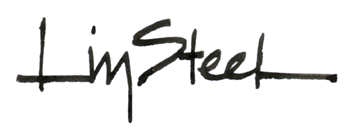
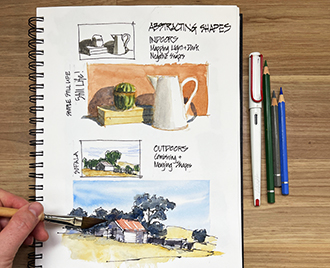

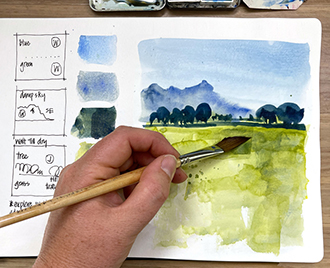
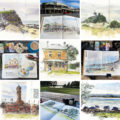
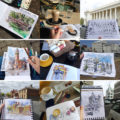
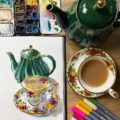
32 Comments
I prefer the Kuretake/Niji with the black plug between the brush and the water vessel (I don’t use the Aquash, but I think it may have the same plug). The plug seems to control the water flow better. I don’t like the Faber-Castell with the dark green cap (also shown in your photo)… it seems much harder to control the water flow. Even though I know results are better with “real” brushes, I made the decision long ago that I would use a waterbrush on location because having to have a cup of water, a place to put it, a place to sit, etc. were preventing me from sketching. And I think it’s more important to sketch, even at the expense of the results, than to be held back by the tool. Looking forward to your report on this! I’d like to learn anything about using a waterbrush to best effect.
I absolutely agree on the Kuretake/Niji brushes as they release less water in cases more control is needed. The “less water” is also important when loading them with pigment. I use a Pentel Aquash for larger wet in wet areas.
Looking forward to your test results
I agree with both these comments! I’ve had some problems with the Pentel clogging up and not giving me enough water or giving me way too much water. I also like this brand for the flat brush they make. There are all kinds of interesting ways to use that.
Hi TIna and Barbara. thanks for your comments. In the past, I’ve actually preferred the wetter type of waterbrush so it will be interesting to revisit using the Niji type with the plug.
I finally came to the same conclusion and have embraced the water brush, too. (Took me long enough!) Trying to find a place to set up with a paintbox, pot of water, etc. was too limiting. The water brush isn’t a great tool for making finished watercolor “paintings,” though I’ve seen it done, but it’s unbeatable for making quick, casual watercolor sketches. The Derwent large size is very nice. Has a big water reservoir, and the bristles are a good size. It seems easier to control the amount of water with the push button on the side vs. squeezing the whole barrel.
https://www.amazon.com/dp/B084Q76X96/ref=twister_B09BV2VFJL?_encoding=UTF8&th=1
Also comes in Medium, Small and Flat, or in a set of four. No affiliation. Just concurring on Tina’s opinion and approach. 🙂
I quite like my Staedtler waterbrushes. They were bought at my local newsagent in Manly so nothing really fancy and I haven’t tried more expensive ones. I like them for convenience and actually pushing out more water when needed to create some flow of colour. My main issue is that after squeezing out the water on release the water seems to act like a suction or syringe sucking coloured water back into the barrel of the brush, making the water then released quite murky quite quickly.
And after returning home I find it takes quite some flushing to replace the dirty water with clean. I would like it not to become so dirty so quickly and wondering if the way I squeeze it has something to do with this ‘sucking back up’ effect.
But all in all I find then quite fun to use, especially in a very small sketch book, facilitating quick and easy sketches.
Hi Ginie – I’ve never experienced that but I think cheaper brands can perform that way. Certainly a feature of a waterbrush that we do not want! A constant clean water supply is the most important aspect!
Just a suggestion: from time to time, consider dipping your water brush into a small container of water as you begin a new wash, or even loading your brush with pigment. I know this seems counter intuitive to what the water brush is designed for, but the result is that you wind up with some new variables in how the pigment goes down on the paper. The thing about water brushes – and it Is the thing that I like, in fact – is that there is such a consistent flow of water coming out of the reservoir. With a “normal” brush , that flow changes as the brush is emptied. Using both techniques in tandem, gives you an extra tool in your Artist toolbelt. Anyway, just a thought.
Great suggestions Mark.
Great idea, Mark! I look forward to trying this.
It will also conserve water in the reservoir which is always lost when I squeeze out a drop of water to really wet the brush.
Hi Mark – thanks so much for your suggestion. In the past, I have used a water container to clean my water brush as it’s so much easier than squeezing water and flushing the bristles. So I’ve probably changed the water amount without releasing it. I will definitely try this more intentionally!
Have you tried the Derwent water brushes, which have a button on the side to regulate the amount of water coming out of the brush? Easier to have juicy washes; some brushes produce watery mixes…
I got a set of 4 of these recently and was very disappointed that the cap won’t post properly on the back end even though they are evidently designed to do that.. I’ll stick with my Pentel Aquash water brushes for now.
Hi Patricia – I’ve got a few Caran d’ache ones with a button but not sure about Derwent. Who knows maybe I do have one in my stash. Thanks for sharing!
I have a couple of Niji water brushes that I used to use all the time. A few years ago, I bought a Pentallic watercolor sketchbook that came with a water brush that looks similar to the blue one in this blog post. It’s my new favorite water brush. It holds a good amount of water and is easier to fill.
Here is a tip for those times when you feel like your water brush is putting out too much water: Hold your sketchbook up so that the barrel of the brush is angled downward; or, at least not angled up. With my water brush, I don’t have to squeeze the barrel unless I am putting down fresh water or cleaning the bristles.
Thanks Donna – yes! holding brush vertical is important to control water flow!
I’ve used them with kids with no problem. Several brushes have an adapter that converts a round brush to a flat. I hold my brush loose so do not have a problem with to much water and kept a small sponge handy for removing the excess water from the brush. It is a very efficient way to paint on location.
Thanks Donella – I know I have a flat waterbrush in my stash somewhere. I remember thinking it was a little dry when I tried it – so will be good to revisit it!
I’m going out sketching this afternoon and I will try using both brands of water brush. I think the key is Liz pointed out is making sure the paint in my paint box is really nice and wet. The only way I can think of to do that is to bring an extra water brush that I can use to squirt water into the pans to make sure they’re wet enough.
I use a very tiny mister from a craft store for spraying on my pans as needed. Or, if a pan is particularly dry (like my UB), I squeeze a small drop of water into it. And, I always squeeze a drop out to be sure the brush is wet before I begin using it.
Hi Patricia – I find that if I pick up a bit of paint as the water flows down from the waterbrush then my paint is moist enough without having to add a separate drop.
I have tried this and it absolutely works. The problem is I don’t really want to drag another water container around but if I have one to hand it does work exactly as Mark describes.
I found a way around this having a little extra water problem. I used a paint pan that has sort of scooped out wells in it and I just squirted the water in one water brush into that so I always had a little extra water if I needed it. But I did have a problem with the Pentel brush again. It was just clogged up and I could not get any water to come out of it. So I dumped that water in the paint well. Not sure why that happens but we do have hard water in my neck of the woods. I should probably fill them up from one of the faucets that has softened water and maybe that would prevent this from happening. Has never happened with the niji water brushes.
thanks for sharing Patricia!
I love that you keep experimenting with different tools, Liz!!
I keep a large Pentel WB in my kit for laying down clean water then dropping in paint for skies (Liz-trick!) but only recently started using one for painting.
I now LOVE the speed/ease of having a little sketchbook, a WB & Art-Tookit Pocket Palette in my pocket for unexpected sketching moments.
A WB works well for me when doing smaller sketches, but I always use water & brush for larger sketches and large washes.
I prefer the Pentel to my first WB (Kuretake) and recently got a 4-pk of different size Pentels (still experimenting). Pentels are also much easier to refill on location than a Kuretake.
A great trick I discovered when preparing for last year’s One Week/100 People challenge was to sketch quickly with water-soluble ink in my Sailor Fude 45 and use the old Kuretake to soften lines and create shadows & depth…a minimalist kit plus great way to keep using a WB after the bristles age & splay. [A Fude 45 works better for me here than a 55.]
thanks Susanna – yes no doubt the waterbrush is super convenient! And traditionally I’ve preferred the Pentel ones too
Thanks for the encouragement. I will need to give them another try.
Hi Nancy – stay tuned for more! 🙂
I had bad luck with my new Faber Castell WB. As hard as I squeezed hardly any moisture appeared and I had a job picking up paint. I retreated home to my tried and true Pentel Aquash WB but will experiment with some other ideas presented here!
Thanks for sharing Linda – I’ve not seriously tried the faber castell one for watercolour sketches
The comments here are a mini class in waterbrushes! I had no idea there were so many brands and features that impact water flow! Time to experiment more! I look forward to seeing how it goes for you on location with a waterbrush!
I was inspired by everyone’s suggestions and Liz assuring me that the ‘sucking back up of dirty water’ problem I was happening isn’t really what water brushes are about. So I bought a Pentel Aquash (large round brush) and a Kuretake (broad flat brush) the other day and both have the black stopper/tap at the top of the water reservoir section which yes stops the dirty water flowing back in! My original waterbrushes didn’t have this feature and it makes a huge difference. Even if now I’m finding the refilling with clean water a touch slow, it’s worth it for the clean water supply!
NEWSLETTER
Subscribe for first notification of workshop + online classes and more.